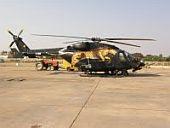 A jinx seems to hover above the armed forces' urgent need for modern attack helicopters to replace the obsolescent Russian Mi-35s, which have been around for three decades. In March, the defence ministry had to cancel a global tender for 22 attack helicopters after international vendors signalled little interest. Meanwhile, the indigenous Light Combat Helicopter (LCH), being developed by Hindustan Aeronautics Ltd (HAL), has run into a serious weight problem.
A jinx seems to hover above the armed forces' urgent need for modern attack helicopters to replace the obsolescent Russian Mi-35s, which have been around for three decades. In March, the defence ministry had to cancel a global tender for 22 attack helicopters after international vendors signalled little interest. Meanwhile, the indigenous Light Combat Helicopter (LCH), being developed by Hindustan Aeronautics Ltd (HAL), has run into a serious weight problem.
Business Standard discovered, during a visit to Bangalore, that the LCH -- which should weight about 2.5 tonnes -- is overweight by some 580 kilograms. For operations in the plains, or in the foothills, this would not be a disaster. But at Himalayan altitudes, near the LCH's ceiling of 6,000 metres (19,685 feet), this would dramatically reduce the helicopter's payload of rockets and missiles.
This weight problem means the LCH's first flight will only take place at the end of this year. Despite the delay, that first Technology Demonstrator, named TD-1, will still be 400 kg heavier than planned.
The Managing Director of HAL's brand new Helicopter Complex, R Srinivasan, told Business Standard that the LCH's weight would be progressively reduced over the first three prototypes. "We will find ways of cutting down TD-1 by 180-200 kg; TD-2, which will fly in mid-2010, will be another 100 kg lighter; and TD-3, which will be ready by end-2010, will shave off another 65-75 kg."
That still adds up to only 375 kg, which means that the LCH could enter production 200 kg heavier than planned. HAL bosses say the IAF has accepted the extra weight.
Attack helicopters are amongst the most difficult combat platforms to successfully engineer. Even a helicopter maker like Sikorsky, which can boast of having designed the legendary Black Hawk helicopter, lost prestige and over $6.9 billion in a failed attempt to develop the Comanche attack helicopter.
But HAL remains confident it can navigate these treacherous waters. Many of the key technologies -- e.g. the Shakti engine, the rotors and the main gearbox -- that will go into the LCH are being concurrently proven in the Dhruv Advanced Light Helicopter (ALH), 159 of which are being built for the army and the air force.
Meanwhile, the weapons and sensor packages that give the LCH its fighting edge are being tested on a weaponised version of the Dhruv. HAL and the IAF have zeroed in on a Nexter 20 mm turret mounted cannon, an MBDA air-to-air missile, and an EW suite from SAAB, South Africa. India's Defence R&D Organisation (DRDO) has begun work on a HELINA missile, which is the successful Nag missile with an extended range of 7 kilometres.
HAL's focus on the LCH is evident. The newly created Helicopter Complex has set up a Mission and Combat Systems R&D Centre, or MCSRDC, which is focusing on developing indigenous glass cockpits for the range of helicopters that HAL intends to churn out, starting with the LCH.
A glass cockpit refers to the tidy digital multi-function display that replaces the earlier clutter of dials and instruments that made flying so difficult.
So far, HAL has imported the glass cockpit displays from Israel Aircraft Industries (IAI) and Sagem, of France. But with a range of helicopters in the making -- including 179 LCHs; 187 Light Utility Helicopters (LUH); and 400 or so Medium Lift Helicopters (MLH) -- there is a need, HAL believes, to develop its own glass cockpits.









